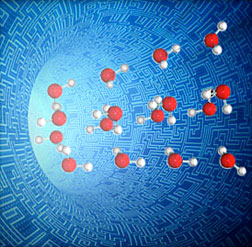- Number 373 |
- October 8, 2012
Solving the chemistry challenges with high performance computing

Researchers at DOE’s Pacific Northwest
National Laboratory are collaborating to
build computational codes for predicting
the structure and function of materials.
When many people think about scientific research, the mental picture is of a scientist in a laboratory, painstakingly mixing chemicals, writing down observations in a notebook, and then doing it all again – and again and again – using seemingly endless combinations to eventually achieve a desired result.
But research practices have come a long way. Scientists now tap into the power of mathematical modeling on sophisticated computers to predict the outcomes from chemical reactions, avoiding large numbers of tedious, dangerous or expensive experiments.
Researchers at DOE’s Pacific Northwest National Laboratory are collaborating to build computational codes with the goal of developing unique capabilities for predicting material properties using some of the world’s largest computing systems.
Historically, computer codes were not designed to take advantage of supercomputers, with hundreds of thousands to millions of processors. Effectively using these computers, which have different architectures, often requires rewriting parts of the codes. However, scientists require the power and flexibility of supercomputers, such as for studies of molecular processes that require highly accurate methods characterized by extremely high numerical complexity.
The technical approach taken to design scientific codes on high performance computers is commonly referred to as a programming model. Such models address the challenges of implementing scientific methods using the operating systems of the machine in a way that leads to highly efficient software.
By using the programming model known as Global Arrays for the development of a computational chemistry software suite, NWChem, scientists at PNNL have enabled scalability and fault tolerance, meaning NWChem can be run on different supercomputers with a minimum of coding changes to handle different architectures. NWChem can also continue to run with supercomputing processors fail. The software suite is used to study a wide range of chemical systems, from the detailed electronic structure of small molecules to the dynamics of large scale biomolecular systems such as solvated enzymes or DNA.
The PNNL-developed Global Arrays has provided the underlying infrastructure that has made NWChem one of the fastest and best-scaling tools available for large machines. The two were concurrently developed to maximize efficiency and versatility, resulting in a variety of quantum mechanical and classical statistical mechanical applications.
Through the use of sophisticated programming models designed specifically for developing scientific software, PNNL scientists are advancing the understanding of molecular properties and chemical processes. Our ultimate goal is enabling the design of new materials with predicted properties and functions.
“Because of this numerical revolution, theory has achieved great predictive power,” says Karol Kowalski, a senior research scientist at the Environmental Molecular Sciences Laboratory located at PNNL. “For example, we can direct our focus to particular, desired properties of molecular systems, and our theoretical calculations can be used to drive experiments.”
The versatility of applications allows PNNL researchers to take a broad look at the role of scientific computing. “It allows for development of new methodologies and new capabilities that allow scientists to do highly accurate modeling and simulation of systems that increasingly approach experimental time and spatial scales,” says TP Straatsma, who leads PNNL’s eXtreme Scale Computing Initiative.
One of those new capabilities is a new programming model that improves scalability, efficiency, and accuracy even further. TASCEL, a task-scheduling library, improves efficiency of a machine’s runtime and communications, with an effective distribution of the work being performed expressed as a collection of smaller units. It allows for applications to be executed with high efficiency across many platforms without requiring significant changes. TASCEL has been demonstrated on DOE leadership-class systems.
“By collaborating, our team can really improve efficiency,” says high performance computing researcher Sriram Krishnamoorthy. “Part of team focuses on the science and the other on the details of the computer architectures.”Submitted by DOE’s Pacific Northwest National Laboratory
